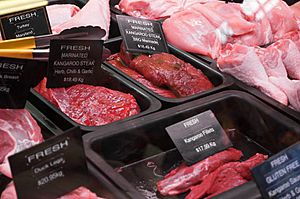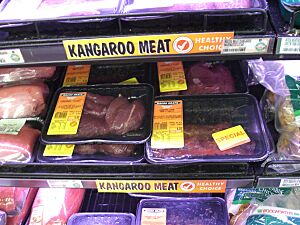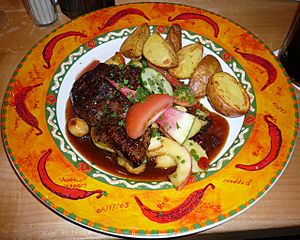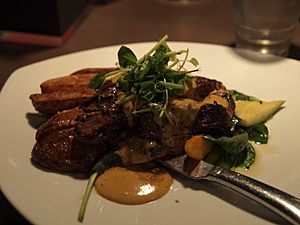Kangaroo meat facts for kids

Kangaroo meat comes from wild kangaroos in Australia. It is sent to over 60 countries around the world.
Contents
How Kangaroo Meat is Produced
Kangaroo meat comes from certain types of kangaroos that are found in large numbers in the wild. Most kangaroos are protected by law in Australia. However, a few large species that have very big populations can be hunted by special commercial hunters.
Some people who care about animal rights don't like this policy. But many Australian scientists who study nature support kangaroo harvesting. Groups like the Ecological Society of Australia believe that using native animals for food, instead of farm animals like sheep, is better for Australia's delicate lands. They also say it can help reduce greenhouse gases.
Scientists estimate kangaroo populations every year using special aerial surveys. These surveys have been improved over nearly 40 years. The number of large kangaroos in commercial hunting areas across Australia is usually between 25 and 50 million.
Kangaroos are protected by laws in Australia. Hunting only happens in special approved areas. Limits are set to make sure there are always enough kangaroos. If kangaroo numbers get too low, hunting areas are closed until populations grow back.
Licensed hunters must follow strict rules to ensure the kangaroos are treated humanely and the meat is safe to eat. Meat sent to other countries is checked by the Australian Quarantine and Inspection Service.
The Australian Government must approve all commercial hunting plans. Only certain species can be hunted, including:
- Red Kangaroo
- Western Grey Kangaroo
- Eastern Grey Kangaroo
- Common Wallaroo
Usually, between 10% and 20% of the estimated kangaroo population can be hunted. These numbers are carefully calculated by government and science groups to keep kangaroo populations healthy.
Often, hunters don't even reach the allowed limits. For example, in 2015, only about 26% of the allowed kangaroos were hunted in Queensland. When commercial hunting doesn't happen enough, landowners might kill kangaroos themselves if there are too many. These kangaroos are usually left to rot and are not used for meat.
Nutrition and Products from Kangaroo Meat

For a long time, kangaroo meat was a main food source for Aboriginal Australians. Kangaroo meat is very healthy. It has a lot of protein and is very low in fat (only about 2%). It also has a high amount of something called conjugated linoleic acid (CLA). CLA is thought to have many health benefits, like helping fight cancer and diabetes, and reducing obesity.
While kangaroo meat is known for being natural and healthy, there hasn't been much research on its full nutrition. However, a major study in 1970 by CSIRO (an Australian science group) looked at its amino acids. Amino acids are the building blocks of protein.
Compared to meats like chicken, pork, beef, and lamb, kangaroo meat has more of some important amino acids. These are threonine, isoleucine, and valine. This information can be helpful for creating balanced diets.
Kangaroo meat became legal for people to eat in South Australia in 1980. Before 1993, it was mostly sold as pet food in other states like New South Wales. Now, it's easier to find in Australia. Many supermarkets sell different cuts, like steaks, minced meat, and even "Kanga Bangas" (kangaroo sausages). Many restaurants in Australia also serve it.
Kangaroo meat has been sent to other countries since 1959. About 70% of it goes overseas, especially to Germany and France. It's sold in some supermarkets in the United Kingdom. In 2008, the kangaroo meat industry was worth about A$250–270 million each year. It also provided around 4,000 jobs in Australia.
Kangaroo meat is also made into pet food.
How to Cook Kangaroo Meat
Kangaroo meat is very lean, meaning it has little fat (only 1–2%). Because of this, you can't cook it the same way you would other red meats. It's best to cook kangaroo meat slowly, or to quickly stir-fry it.
Animal Welfare Concerns
Some animal rights groups in Australia and other countries have concerns about the kangaroo meat industry. Their main worry is about how kangaroos are hunted in the wild.
In 2009, a scientist estimated that about 440,000 young kangaroos might die each year after their mothers are shot. However, kangaroo hunters must follow a strict Code of Practice. This code has clear rules to make sure young kangaroos are not left to starve. A 2020 report also suggested that commercial hunting might be more humane than other ways of controlling kangaroo populations.
In the United Kingdom, selling kangaroo meat has led to protests from animal welfare groups. Some supermarkets, like Lidl, Iceland, Tesco, and Morrisons, have stopped selling kangaroo meat because of customer feedback.
When commercial hunting decreases due to these campaigns, it can lead to more non-commercial culling of kangaroos. This means landowners might kill kangaroos themselves if there are too many. These non-commercial killings are often done by people who are not professional hunters. It's harder to check if these killings are humane. Also, kangaroos killed this way cannot be sold, so they are often left to rot instead of being used as a resource.
Kangatarianism: An Ethical Choice
Kangatarianism is a newer way of eating. People who are "kangatarians" avoid all meat except kangaroo. They choose this diet for reasons related to the environment and ethics.
Australian newspapers started talking about "kangatarianism" in 2010. People choose it because wild kangaroos don't need extra land or water for farming. They also produce less methane, which is a greenhouse gas, compared to cows or other farm animals. Kangatarians also believe that Australian kangaroos live natural lives and are killed humanely. For similar reasons, some Australians have thought about eating only the meat of Australian feral camels.
Finding a New Name for Kangaroo Meat
The kangaroo meat industry has thought about giving kangaroo meat a special culinary name. This would be like how pig meat is called ham or pork, and deer meat is called venison. The idea is to help people think of the meat as food, rather than thinking about the animal itself, especially since kangaroos are seen as cute.
In 2005, a magazine held a competition to find a new name. Over 2,700 ideas came from 41 countries. The chosen name was australus. This name was suggested by Steven West, an American professor who was becoming an Australian citizen. Other names suggested included kangarly, maroo, krou, and jumpmeat.
The kangaroo industry has not officially started using the new name.
Traditional Aboriginal Use of Kangaroo
Kangaroo was a very important food source for many traditional Aboriginal groups.
The Arrernte people of Central Australia call kangaroo Kere aherre. They used to hunt kangaroos with dogs and spears. After catching a kangaroo, they would prepare it by removing some parts and cooking it in a hole with hot earth and coals. They would cut the kangaroo into many pieces so that many people could share it. They even drank the warm blood and fluids, which studies have shown are safe.
The Anangu, Pitjantjatjara, and Yankunytjatjara peoples of Central Australia call kangaroo "malu". They mainly use malu for meat (kuka). But they also use other parts for making spears. Kangaroos are also important totem animals for them. Rangers in the Angas Downs Indigenous Protected Area are working to help increase kangaroo numbers. This is called Kuka Kanyini, which means "looking after game animals."
See also
 In Spanish: Carne de canguro para niños
In Spanish: Carne de canguro para niños




